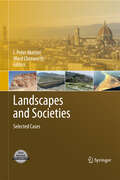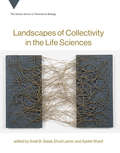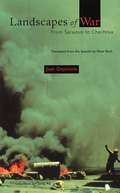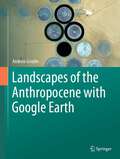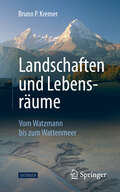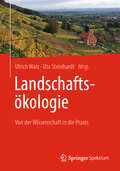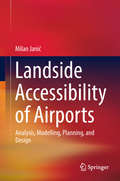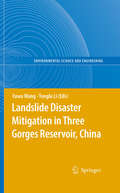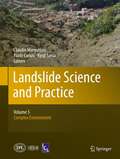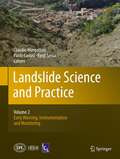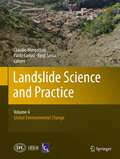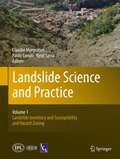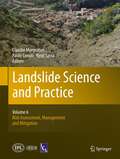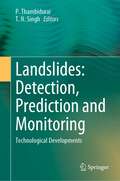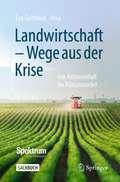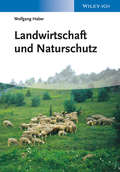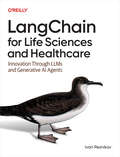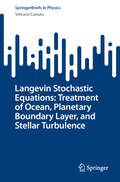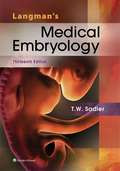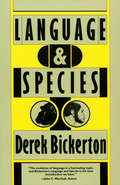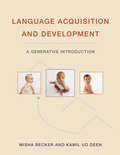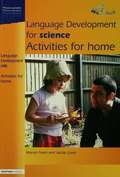- Table View
- List View
Landscapes and Societies
by I. Peter Martini Ward ChesworthThis book contains case histories intended to show how societies and landscapes interact. The range of interest stretches from the small groups of the earliest Neolithic, through Bronze and Iron Age civilizations, to modern nation states. The coexistence is, of its very nature reciprocal, resulting in changes in both society and landscape. In some instances the adaptations may be judged successful in terms of human needs, but failure is common and even the successful cases are ephemeral when judged in the light of history. Comparisons and contrasts between the various cases can be made at various scales from global through inter-regional, to regional and smaller scales. At the global scale, all societies deal with major problems of climate change, sea-level rise, and with ubiquitous problems such as soil erosion and landscape degradation. Inter-regional differences bring out significant detail with one region suffering from drought when another suffers from widespread flooding. For example, desertification in North Africa and the Near East contrasts with the temperate countries of southern Europe where the landscape-effects of deforestation are more obvious. And China and Japan offer an interesting comparison from the standpoint of geological hazards to society - large, unpredictable and massively erosive rivers in the former case, volcanoes and accompanying earthquakes in the latter. Within the North African region localized climatic changes led to abandonment of some desertified areas with successful adjustments in others, with the ultimate evolution into the formative civilization of Egypt, the "Gift of the Nile". At a smaller scale it is instructive to compare the city-states of the Medieval and early Renaissance times that developed in the watershed of a single river, the Arno in Tuscany, and how Pisa, Siena and Florence developed and reached their golden periods at different times depending on their location with regard to proximity to the sea, to the main trunk of the river, or in the adjacent hills. Also noteworthy is the role of technology in opening up opportunities for a society. Consider the Netherlands and how its history has been formed by the technical problem of a populous society dealing with too much water, as an inexorably rising sea threatens their landscape; or the case of communities in Colorado trying to deal with too little water for farmers and domestic users, by bringing their supply over a mountain chain. These and others cases included in the book, provide evidence of the successes, near misses and outright failures that mark our ongoing relationship with landscape throughout the history of Homo sapiens. The hope is that compilations such as this will lead to a better understanding of the issue and provide us with knowledge valuable in planning a sustainable modus vivendi between humanity and landscape for as long as possible. Audience: The book will interest geomorphologists, geologists, geographers, archaeologists, anthropologists, ecologists, environmentalists, historians and others in the academic world. Practically, planners and managers interested in landscape/environmental conditions will find interest in these pages, and more generally the increasingly large body of opinion in the general public, with concerns about Planet Earth, will find much to inform their opinions. Extra material: The color plate section is available at http://extras.springer.com
Landscapes of Collectivity in the Life Sciences (Vienna Series in Theoretical Biology #20)
by Ayelet Shavit Ehud Lamm Snait GissisBroad perspective on collectivity in the life sciences, from microorganisms to human consensus, and the theoretical and empirical opportunities and challenges. Many researchers and scholars in the life sciences have become increasingly critical of the traditional methodological focus on the individual. This volume counters such methodological individualism by exploring recent and influential work in the life sciences that utilizes notions of collectivity, sociality, rich interactions, and emergent phenomena as essential explanatory tools to handle numerous persistent scientific questions in the life sciences. The contributors consider case studies of collectivity that range from microorganisms to human consensus, discussing theoretical and empirical challenges and the innovative methods and solutions scientists have devised. The contributors offer historical, philosophical, and biological perspectives on collectivity, and describe collective phenomena seen in insects, the immune system, communication, and human collectivity, with examples ranging from cooperative transport in the longhorn crazy ant to the evolution of autobiographical memory. They examine ways of explaining collectivity, including case studies and modeling approaches, and explore collectivity's explanatory power. They present a comprehensive look at a specific case of collectivity: the Holobiont notion (the idea of a multi-species collective, a host and diverse microorganisms) and the hologenome theory (which posits that the holobiont and its hologenome are a unit of adaption). The volume concludes with reflections on the work of the late physicist Eshel Ben-Jacob, pioneer in the study of collective phenomena in living systems. Contributors Oren Bader, John Beatty, Dinah R. Davison, Daniel Dor, Ofer Feinerman, Raghavendra Gadagkar, Scott F. Gilbert, Snait B. Gissis, Deborah M. Gordon, James Griesemer, Zachariah I. Grochau-Wright, Erik R. Hanschen, Eva Jablonka, Mohit Kumar Jolly, Anat Kolumbus, Ehud Lamm, Herbert Levine, Arnon Levy, Xue-Fei Li, Elisabeth A. Lloyd, Yael Lubin, Eva Maria Luef, Ehud Meron, Richard E. Michod, Samir Okasha, Simone Pika, Joan Roughgarden, Eugene Rosenberg, Ayelet Shavit, Yael Silver, Alfred I. Tauber, Ilana Zilber-Rosenberg
Landscapes of War: From Sarajevo to Chechnya
by Juan Goytisolo Peter BushAn incisive examination of the tensions that exist between the West and Islamic societies of Europe, North Africa, and the Middle East. Provides rich historical analysis and reportage of life in four explosive war-zones: Sarajevo, Algeria, the West Bank and Gaza, and Chechnya. Translated by Peter Bush.
Landscapes of the Anthropocene with Google Earth
by Andrew GoudieThis book considers the meaning of the term, considers the value and characteristics of Google Earth, and discusses the main driving forces of landscape change. Google Earth provides a means whereby one can identify changes in the landscapes of Earth over recent decades. This has been a time of great human activity, and landscapes have been transformed as a result of such factors as land use and land-cover change, climate change, the intensive harnessing of new energy sources, population pressures, and globalization. Many geologists now believe that the whole Earth System is being changed and that there is thus a need to introduce the concept of the Anthropocene. It then looks at specific landscape types, including rivers, coasts, lakes, deserts, tundra, and glaciers.
Landschaften und Lebensräume: Vom Watzmann bis zum Wattenmeer
by Bruno P. KremerIn allen seinen Teilgebieten weist Mitteleuropa eine beachtliche natur- und kulturlandschaftliche Vielfalt auf, die unser Erleben draußen enorm bereichert. Vom Hochgebirge bis zur Küste laden äußerst unterschiedliche Lebensraum-Ensembles zur aktiven Erkundung ein. Erfahren Sie in diesem Buch u.a. · wie die zurückliegenden Eiszeiten Gletschertore geschaffen und die Landschaft im Voralpenland modelliert haben · wo in Norddeutschland noch vor etwa 10000 Jahren die Vereisungsgrenzen verliefen · was entlang von Fließgewässern vom kleinen Gebirgsbach bis zum großen Strom zu beobachten ist · weshalb auch die Stillgewässer nicht nur der großen Seenplatten äußerst erlebniswerte Lebensräume darstellen · warum auch vom Menschen geschaffene Ersatzstandorte wie Ackersäume und Wiesen wertvolle Biotope darstellen · was in den Nationalparkgebieten an der Nordseeküste Erlebniswertes auf Sie wartet Dieses Buch bietet mit seinen sorgsam ausgewählten Fallbeispielen zwar keine enzyklopädische Komplettübersicht, aber doch eine animativ-themenreiche Anregung zum aktiveren Erleben und Wahrnehmen der besonderen Facetten unseres heimischen Ambientes.
Landschaftsökologie: Von der Wissenschaft in die Praxis
by Ulrich Walz Uta SteinhardtLandschaft ist ein wichtiger Schlüssel zur Nachhaltigkeit. Aktuelle Krisen wie der Biodiversitätsverlust und der Klimawandel verlangen nach integrativen Betrachtungsweisen und Lösungsansätzen zu unserem Umgang mit Landschaft, den wir grundlegend ändern müssen. Landschaftsökologie will genau das: fach- und sektorübergreifend analysieren und Lösungen aufzeigen. „Der Blick auf’s Ganze“, auf Landschaft, die mehr ist als die Summe ihrer Teile, zeichnet die landschaftsökologische Arbeitsweise aus. Darum geht es auch in diesem Buch: natur-, sozial- und kulturwissenschaftliche sowie planerische Sichtweisen auf die Probleme unserer Zeit aufzuzeigen und zu verbinden. Landschaftsökologischen Institutionen aus Deutschland geben Einblicke in die aktuell von ihnen bearbeiteten Themen und zeigen so die Leistungsfähigkeit des Faches insgesamt auf. Ziel des Werkes ist es, die aktuelle Bandbreite landschaftsökologischer Forschung anhand zahlreicher Beispiele zu verdeutlichen und dieFachkolleg_innen und Studierende der Landschaftsökologie und verwandter Fächer wie Geographie, Umweltwissenschaften, Biologie, Ökologie, etc. zu erreichen.
Landside Accessibility of Airports: Analysis, Modelling, Planning, And Design
by Milan JanićThis book covers the analysis, modelling, planning, and design of airport landside access modes and their systems. It elaborates on the issues and related problems of airport landside accessibility in an innovative, comprehensive and systematic way. In addition to the general concept of accessibility, the book addresses the analysis and modelling of infrastructure-related, technological, operational, economic, social and environmental performance of road- and rail-based transport systems, as well as the core principles of their planning and design. The book provides guidelines on the modelling, planning, and design of airport landside access modes and their systems, which will contribute to the overall sustainable development of airports. Its main features are: presents a multidimensional examination of performance for specific airport landside access modes and their systems; pursues a qualitative and quantitative approach to developing performance indicators for estimating the sustainability of airport landside access modes and their systems; includes illustrative cases of airport landside accessibility, and numerical examples as exercises for assessing performance using the systems’ indicators. As such, the book offers a valuable source of information for all practitioners involved in analysing, planning and designing more environmentally friendly airport access modes and systems, and who want to learn how to overcome the issues and problems surrounding landside accessibility. It will also benefit students studying the analysis and modelling of transportation systems, and researchers seeking to promote improved sustainability at airports.
Landslide Disaster Mitigation in Three Gorges Reservoir, China
by Tonglu Li Fawu WangThis book presents the research results on landslide disaster mitigation in Three Gorges Reservoir, China. It consists of three parts. (1) Regional properties of landslides in this area, (2) Case studies about some typical landslides, and (3) New methodologies applied in this area. It provides useful information to academics, practitioners, and university students working on landslide disaster mitigation, especially for large engineering projects. This book can also be used as an information source for geo-hazards in the Three Gorges Reservoir Area.
Landslide Ecology
by Lawrence R. Walker Aaron B. ShielsDespite their often dangerous and unpredictable nature, landslides provide fascinating templates for studying how soil organisms, plants and animals respond to such destruction. The emerging field of landslide ecology helps us understand these responses, aiding slope stabilisation and restoration and contributing to the progress made in geological approaches to landslide prediction and mitigation. Summarising the growing body of literature on the ecological consequences of landslides, this book provides a framework for the promotion of ecological tools in predicting, stabilising, and restoring biodiversity to landslide scars at both local and landscape scales. It explores nutrient cycling; soil development; and how soil organisms disperse, colonise and interact in what is often an inhospitable environment. Recognising the role that these processes play in providing solutions to the problem of unstable slopes, the authors present ecological approaches as useful, economical and resilient supplements to landslide management.
Landslide Science and Practice: Complex Environment
by Claudio Margottini Kyoji Sassa Paolo CanutiThis book contains peer-reviewed papers from the Second World Landslide Forum, organised by the International Consortium on Landslides (ICL), that took place in September 2011. The entire material from the conference has been split into seven volumes, this one is the fifth: 1. Landslide Inventory and Susceptibility and Hazard Zoning, 2. Early Warning, Instrumentation and Monitoring, 3. Spatial Analysis and Modelling, 4. Global Environmental Change, 5. Complex Environment, 6. Risk Assessment, Management and Mitigation, 7. Social and Economic Impact and Policies.
Landslide Science and Practice: Early Warning, Instrumentation and Monitoring
by Claudio Margottini Kyoji Sassa Paolo CanutiThis book contains peer-reviewed papers from the Second World Landslide Forum, organised by the International Consortium on Landslides (ICL), that took place in September 2011. The entire material from the conference has been split into seven volumes, this one is the second: 1. Landslide Inventory and Susceptibility and Hazard Zoning, 2. Early Warning, Instrumentation and Monitoring, 3. Spatial Analysis and Modelling, 4. Global Environmental Change, 5. Complex Environment, 6. Risk Assessment, Management and Mitigation, 7. Social and Economic Impact and Policies.
Landslide Science and Practice: Global Environmental Change
by Claudio Margottini Kyoji Sassa Paolo CanutiThis book contains peer-reviewed papers from the Second World Landslide Forum, organised by the International Consortium on Landslides (ICL), that took place in September 2011. The entire material from the conference has been split into seven volumes, this one is the fourth: 1. Landslide Inventory and Susceptibility and Hazard Zoning, 2. Early Warning, Instrumentation and Monitoring, 3. Spatial Analysis and Modelling, 4. Global Environmental Change, 5. Complex Environment, 6. Risk Assessment, Management and Mitigation, 7. Social and Economic Impact and Policies.
Landslide Science and Practice: Landslide Inventory and Susceptibility and Hazard Zoning
by Claudio Margottini Kyoji Sassa Paolo CanutiThis book contains peer-reviewed papers from the Second World Landslide Forum, organised by the International Consortium on Landslides (ICL), that took place in September 2011. The entire material from the conference has been split into seven volumes, this one is the first: 1. Landslide Inventory and Susceptibility and Hazard Zoning, 2. Early Warning, Instrumentation and Monitoring, 3. Spatial Analysis and Modelling, 4. Global Environmental Change, 5. Complex Environment, 6. Risk Assessment, Management and Mitigation, 7. Social and Economic Impact and Policies.
Landslide Science and Practice: Risk Assessment, Management and Mitigation
by Claudio Margottini Kyoji Sassa Paolo CanutiThis book contains peer-reviewed papers from the Second World Landslide Forum, organised by the International Consortium on Landslides (ICL), that took place in September 2011. The entire material from the conference has been split into seven volumes, this one is the sixth: 1. Landslide Inventory and Susceptibility and Hazard Zoning, 2. Early Warning, Instrumentation and Monitoring, 3. Spatial Analysis and Modelling, 4. Global Environmental Change, 5. Complex Environment, 6. Risk Assessment, Management and Mitigation, 7. Social and Economic Impact and Policies.
Landslide Science and Practice: Social and Economic Impact and Policies
by Claudio Margottini Kyoji Sassa Paolo CanutiThis book contains peer-reviewed papers from the Second World Landslide Forum, organised by the International Consortium on Landslides (ICL), that took place in September 2011. The entire material from the conference has been split into seven volumes, this one is the seventh: 1. Landslide Inventory and Susceptibility and Hazard Zoning, 2. Early Warning, Instrumentation and Monitoring, 3. Spatial Analysis and Modelling, 4. Global Environmental Change, 5. Complex Environment, 6. Risk Assessment, Management and Mitigation, 7. Social and Economic Impact and Policies.
Landslide Science and Practice: Spatial Analysis and Modelling
by Claudio Margottini Kyoji Sassa Paolo CanutiThis book contains peer-reviewed papers from the Second World Landslide Forum, organised by the International Consortium on Landslides (ICL), that took place in September 2011. The entire material from the conference has been split into seven volumes, this one is the seventh: 1. Landslide Inventory and Susceptibility and Hazard Zoning, 2. Early Warning, Instrumentation and Monitoring, 3. Spatial Analysis and Modelling, 4. Global Environmental Change, 5. Complex Environment, 6. Risk Assessment, Management and Mitigation, 7. Social and Economic Impact and Policies.
Landslides: Technological Developments
by T. N. Singh P. ThambiduraiThis book intends to decipher the knowledge in the advancement of understanding, detecting, predicting, and monitoring landslides. The number of massive landslides and the damages they cause has increased across the globe in recent times. It is one of the most devastating natural hazards that cause widespread damage to habitat on a local, regional, and global scale. International experts provide their experience in landslide research and practice to help stakeholders mitigate and predict potential landslides. The book comprises chapters on: Dynamics, mechanisms, and processes of landslides; Geological, geotechnical, hydrological, and geophysical modelling for landslides; Mapping and assessment of hazard, vulnerability, and risk associated with landslides; Monitoring and early warning of landslides; Application of remote sensing and GIS techniques in monitoring and assessment of landslides. The book will be of interest to researchers, practitioners, and decision-makers in adapting suitable modern techniques for landslide study.
Landwirtschaft - Wege aus der Krise: von Artenvielfalt bis Klimawandel
by Eva GottfriedLandwirtschaft geht uns alle an!Mit immer ertragreicheren Sorten, modernen Düngemitteln und potenten Pestiziden haben wir jahrelang eine intensivierte Landwirtschaft auf Kosten der Natur vorangetrieben. Nun schielen immer mehr Landwirte auf naturnahe, nachhaltige Ansätze. Doch was bedeutet dies für die Agrarwirtschaft? Sind an den Klimawandel angepasste Kulturpflanzen nachhaltig? Und sollen wir diese durch klassische, langwierige Züchtung entwickeln oder ist grüne Gentechnik durch Schnelligkeit im Vorteil? Wie steht es um Patente auf Naturprodukte? Können wir die Agrarwirtschaft in unsere immer größeren Städte integrieren und vielleicht durch Digitalisierung retten? Die im Buch gesammelten Beiträge aus Spektrum der Wissenschaft, Spektrum – die Woche und Spektrum.de bieten vielfältige Ansätze und Denkanstöße mit Blick auf Herausforderungen, Risiken und Möglichkeiten für ein Umlenken in der Landwirtschaft.
Landwirtschaft und Naturschutz
by Wolfgang HaberProfessor Wolfgang Haber ist Vorkämpfer und seit vier Jahrzehnten wichtigster Exponent des Natur- und Landschaftsschutzes in Deutschland. In dieser umfassenden und aktuellen Übersicht setzt er sich kritisch mit der Wechselbeziehung zwischen landwirtschaftlicher Nutzung und dem Schutz von ländlichen Lebensräumen auseinander. Getreu seinem Credo, dass es eine nicht umweltbelastende Landwirtschaft nicht geben kann, entwirft Haber das Leitbild einer multifunktionalen Landwirtschaft – mit einer differenzierten Boden- und Landnutzung, die den Zielen der Erzeugung hochwertiger und sicherer Nahrung ebenso verpflichtet ist wie der Erhaltung der ländlichen Kulturlandschaft und ihrer vielfältigen Biotope. In einem Spannungsbogen vom Beginn der Landwirtschaft im Neolithikum bis hin zur heutigen staatlich gelenkten Agrarindustrie zeichnet er Entwicklungen und Prozesse nach, die unsere heutige Kulturlandschaft geformt haben und analysiert deren Einfluss auf Nachhaltigkeit der Landnutzung, biologische Vielfalt und Leistungsfähigkeit der Ökosysteme von Ackerland, Grünland und Sonderkulturen wie Obst- und Weinbau. Zahlreiche Fallbeispiele aus Deutschland, Österreich und der Schweiz sowie eine Vielzahl von aktuellen Daten runden das Werk ab und liefern wertvolles Material für eine sachliche Auseinandersetzung mit einem Thema, welches völlig zu Recht immer stärker in den öffentlichen Diskurs Eingang findet.
LangChain for Life Sciences and Healthcare: Innovation Through LLMs and Generative AI Agents
by Ivan ReznikovFeeling overwhelmed by the volume of data in your research? Sifting through massive amounts of data to find useful insights is becoming increasingly difficult in drug discovery, genetics, and healthcare. Enter the era of generative AI with LangChain, whose groundbreaking tools are changing the way life scientists and researchers operate. In this groundbreaking book, Dr. Ivan Reznikov teaches you to harness the power of AI to elevate your research capabilities. Divided into two parts, the first is essential for any specialist, covering the transition from traditional statistics to generative AI, the fundamentals of large language models, and the practical uses of LangChain. The second part is designed for life science professionals who want to create AI applications for biology, chemistry, drug development, and more. By the end, you will: Learn how to easily create and integrate LangChain applications into research Discover how to substantially accelerate your experimental and data analysis operations Explore cutting-edge AI solutions designed to address complex research problems Gain the skills and knowledge to advance your career in AI-enhanced life sciences
Langevin Stochastic Equations: Treatment of Ocean, Planetary Boundary Layer, and Stellar Turbulence (SpringerBriefs in Physics)
by Vittorio CanutoThis book derives, solves, and assesses the Langevin Stochastic Equations (LSE) as a tool for treating turbulent flows. Previous work has demonstrated the LSE's ability to successfully describe non-geophysical turbulent flows. However, this book specifically focuses on geophysical flows. Chapter I addresses the modeling of oceanic mesoscales (M) and sub-mesoscales (SM), while Chapter II discusses vertical mixing. The target audience for this book is advanced students and researchers interested in future climate change and the crucial role played by the ocean. One of the main challenges in describing oceanic M and SM is that they are governed by non-linear interactions for which no satisfactory model exists. Despite the unsuccessful attempts to describe non-linearity using the traditional Navier-Stokes Equations (NSE), heuristic models continue to be used. This has created a dilemma: while future climate projections need to be predictive, the heuristic treatment of M and SM lacks predictive power, leading to an internal inconsistency. The primary goal of this book is to demonstrate that the transition from NSE to LSE resolves this inconsistency, paving the way for a fully predictive treatment of M and SM. This advancement is crucial for providing future climate predictions with the credibility they require.
Langman’s Medical Embryology, Thirteenth Edition
by T. W. SadlerLangman's Medical Embryology is organized into two parts. The first provides an overview of early development from gametogenesis through the embryonic period. Also included in this section are chapters on placental and fetal development as well as prenatal diagnosis and birth defects. The second part of the text provides a description of the fundamental processes of embryogenesis for each organ system.
Language & Species
by Derek BickertonThe classic work on the origins and evolution of language from the pioneering linguist and author of Adam&’s Tongue.Language and Species presents the most detailed and well-documented scenario to date of the origins of language. Drawing on "living linguistic fossils" such as "ape talk," the "two-word" stage of small children, and pidgin languages—as well as important discoveries in paleoanthropology—Bickerton shows how a primitive "protolanguage" could have offered Homo erectus a novel ecological niche. He goes on to demonstrate how this protolanguage could have developed into the languages we speak today."You are drawn into [Bickerton's] appreciation of the dominant role language plays not only in what we say, but in what we think and, therefore, what we are."—Robert Wright, New York Times Book Review "The evolution of language is a fascinating topic, and Bickerton's Language and Species is the best introduction we have."—John C. Marshall, Nature
Language Acquisition and Development: A Generative Introduction
by Misha Becker Kamil Ud DeenAn introduction to the study of children's language development that provides a uniquely accessible perspective on generative/universal grammar–based approaches.How children acquire language so quickly, easily, and uniformly is one of the great mysteries of the human experience. The theory of Universal Grammar suggests that one reason for the relative ease of early language acquisition is that children are born with a predisposition to create a grammar. This textbook offers an introduction to the study of children's acquisition and development of language from a generative/universal grammar–based theoretical perspective, providing comprehensive coverage of children's acquisition while presenting core concepts crucial to understanding generative linguistics more broadly. After laying the theoretical groundwork, including consideration of alternative frameworks, the book explores the development of the sound system of language—children's perception and production of speech sound; examines how words are learned (lexical semantics) and how words are formed (morphology); investigates sentence structure (syntax), including argument structure, functional structure, and tense; considers such “nontypical” circumstances as acquiring a first language past infancy and early childhood, without the abilities to hear or see, and with certain cognitive disorders; and studies bilingual language acquisition, both simultaneously and in sequence.Each chapter offers a summary section, suggestions for further reading, and exercises designed to test students' understanding of the material and provide opportunities to practice analyzing children's language. Appendixes provide charts of the International Phonetic Alphabet (with links to websites that allow students to listen to the sounds associated with these symbols) and a summary of selected experimental methodologies.
Language Development for Science: Activities for Home
by Marion Nash Jackie LoweThese simple play-based activities are ideal for teachers to copy and give out to parents who want to know how to help their child improve his or her science language skills and have fun at the same time. Activities are linked directly to the school-based Language Development Circle Time sessions, but can also be used independently. There is a clear structure and progression of ideas, with supporting black-line drawings to acts as prompts and simple record - keeping system to support home/school communication.
